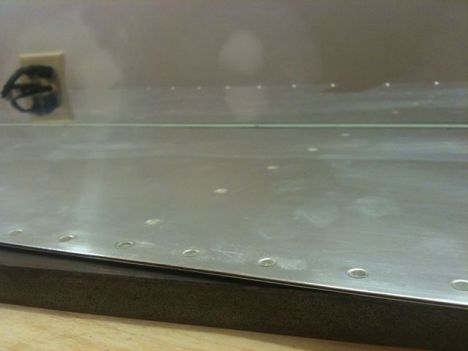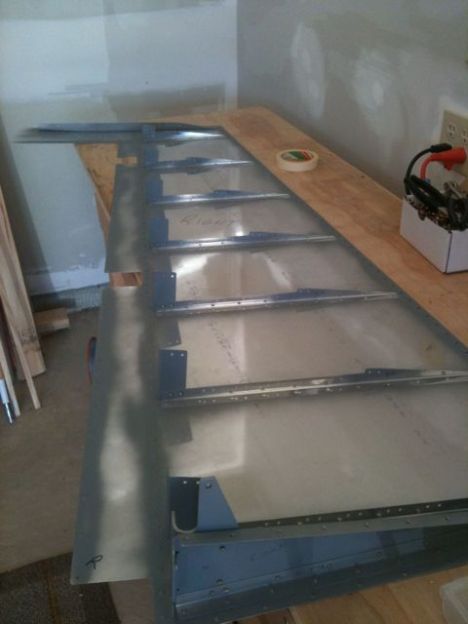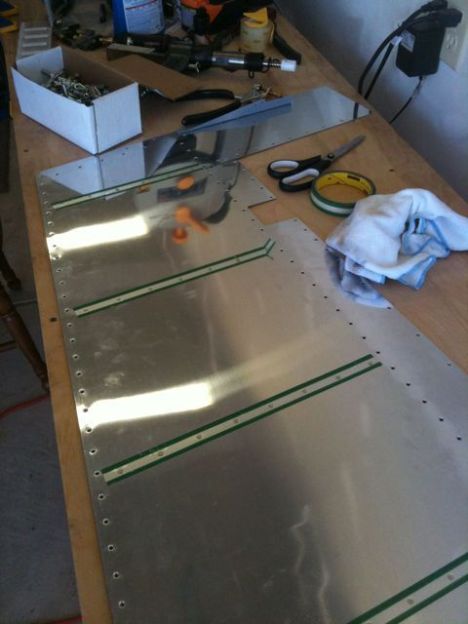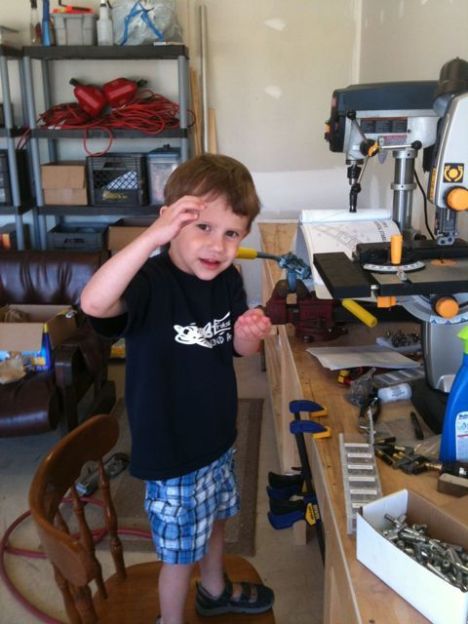Posted on June 11, 2010 by mayrv10
Pictures can’t do it justice. This trailing edge turned out absolutely perfect. The long 1/2″-thick slab of cold-rolled steel served well as the back-rivet plate and we followed the plans pretty closely. Only difference was instead of flipping the rudder over and finishing the machine heads with the mushroom set, we decided to do the shop heads with the mushroom set. Many thanks to Mike Cencula for coming down to help. I have no doubt it would not have turned out this nice if it were not for his help.

Filed under: Empennage | 1 Comment »
Posted on May 7, 2010 by mayrv10
Got some excellent work done on the rudder this week. I primed the stiffeners and anywhere two pieces will touch with NAPA 7220. Then I got my first experience with back-riveting. I really enjoyed it. The enormous slab of steel I bought at a local shop did the trick as a back-rivet plate and the rivets on the rudder skins turned out great. I did some more riveting and I’m all ready to close out the rudder.



Filed under: Empennage | Leave a comment »
Posted on February 8, 2010 by mayrv10
Super bowl Sunday and we are all snowed in. We have about ten inches on the ground. It snowed all weekend but today was a beautiful day to dig out.
Last night, I took all of the rudder components – ribs, spar and skins – inside the house and sat down in the family room to deburr the rivet holes. It sounds so simple, but that is not something I had the luxury of doing when the project was at the hangar.
After putting the snowblower through the paces, I decided to setup the dimpling c-frame in the basement where I have a little more room. I was able to get nearly all the holes dimpled in both skins. I’m very pleased with the results from the cleaveland c-frame tool. The dimples are very crisp and it’s not too loud at all. I also like using the pneumatic squeezer to dimple along the edges, but it’s a lot easier to put a hole where one shouldn’t be when you’re using the squeezer.
I met Rick Blaes at the Home Depot (a.k.a. “Homer’s”). We picked up a bunch of drywall and related supplies so I can finish the garage this week. Hopefully I can get around to that and still make some progress on the plane.
Filed under: Empennage | Leave a comment »
Posted on January 24, 2010 by mayrv10
It’s been nearly 5 months since my last post, so here’s a recap:
I moved the project to a hangar at Newark (KVTA) in September. As it started getting cold, I didn’t get much work in on the project. I spent the month of October laid up sick. We had a new baby in October. I spent nearly every minute of November and December at work finishing up the year and making up for lost time. All in all, I think I got in about 2 hours of work on the plane in the four-and-a-half months it was at the hangar.
Since apparently that wasn’t enough to convince me to bring the project back to the house, my good friend and fellow RV-builder Rick Blaes offered his assistance and encouraged me to get a moving date on the calendar. Together, we piled everything into his truck and after two trips – and one stop at Route 62 BBQ – we had everything back into the garage.
This afternoon, Ashley and I arranged the garage into a workshop of sorts. We also finally got around to breaking down the crate that the kit had come in. She was a big help.
The next step is to insulate the outside wall of the garage and the door itself. That will go a long way towards helping me to work there during the cold months. I should be back to building very soon!
Filed under: Empennage, Workshop Setup | Leave a comment »
Posted on September 1, 2009 by mayrv10
I was so motivated after getting the Vertical Stabilizer put together that I got a lot done on the rudder this weekend. In between work and a fantasy football draft, I got both the skins and all the parts deburred. Then, I assembled the ribs – they are each made of two stiffeners riveted together – and clecoed the whole thing together to match-drill. It’s fun to see so much progress.
I was eating lunch over at the Newark-Heath airport yesterday and decided it was finally time to get my medical renewed and take my flight review so I am current. I’ve got both on the calendar this week. Ashley pointed out that it will be nice to be able to discuss my pilot’s license around friends without needing the disclaimer “well, yes, I have my pilot’s license, but I don’t really FLY.”
Filed under: Empennage | 1 Comment »
Posted on August 29, 2009 by mayrv10
Over the last week I was able to make some great progress. I bought a couple of cans of NAPA 7220 Primer at the store in Reynoldsburg (the folks there gave excellent service). I had decided that I would simply prime the areas where the aluminum pieces would touch each other, simply adding another minimal layer of corrosion protection. It doesn’t take hardly any time at all and it certainly cannot hurt.
Last night, Mike Cencula came over and we went to town on the riveting of the components of the VS. Mike helped me to get a hang of how to better use the rivet gun and rivet squeezer. We worked late and ended up finishing the VS (less the rivets on the edges) around 11:30. Thanks for all your help, Mike!
Filed under: Empennage | Leave a comment »
Posted on August 21, 2009 by mayrv10
We’ve made some good progress in the last couple of weeks. I got a C-frame dimpler and table kit from Cleaveland Tools. The table is extremely helpful because it keeps the piece of aluminum perpendicular to the dimple dies when I’m dimpling. This makes sure the dimples are nice and crisp. With two not-so-hard whacks of the hammer, it makes a great dimple.
Cousin Tim stopped by this week on his way back to Taylor, and it was great to see him. We only had a couple of hours to work on the plane, and it was really hot and muggy, but we got a lot done. We deburred the edges of the new VS-1007 rib (I put an extra dimple where there was not supposed to be one with my pneumatic squeezer) and fitted the skeleton back together so we could final-drill the holes where the flanges meet the skin. Also, we countersank the doubler that goes on the bottom of the forward VS spar.
Which brings up a good point. Countersinking is difficult enough, but it’s even harder when you are attempting to countersink a piece to accept a dimpled skin. It’s not that it’s hard, it’s just that it is difficult to know when you’ve gone deep enough. It’s better to start shallow and increase the depth of the cut as you go. I’ve got a sense now for how tight the fit needs to be. The surrounding skins aren’t going to be completely flush until you rivet, but they need to have a pretty close fit when you put that dimpled skin up against the countersink.
Today, Ashley held the skin in place while I used the C-frame to dimple the remaining holes on the VS skin. The dimples look great to me.
Next step is to run to NAPA to grab some 7220 “Martin Senior” self-etching primer. In my next post, I’ll discuss my ideas on priming. Those seem to change from day-to-day, but lately I’m feeling like “less is more”…
Filed under: Empennage | Leave a comment »
Posted on August 9, 2009 by mayrv10
This week I had the opportunity to go help fellow EAA chapter 9 member Mike Cencula work on his RV-7a. He needed some help so I decided what better way to gain some experience? Another RV builder John Bowen met us and the three of us had a lot of fun. I drove my first rivet after watching and learning from John’s technique. It was great to see Mike’s shop. He has quite an impressive setup.
I learned some things and got some ideas to take home with me:
1. Put the compressor in the basement and run a line to the garage. I did this today and the noise has become a non-factor. It makes all the difference in the world.
2. Using the traditional C-frame dimpler rather than the DRDT-2 is a possibility. The C-frame is harder to use but (according to Mike) makes crisper dimples. He seems like he knows what he’s talking about.
3. This is a HUGE project. I seem to forget that from time to time.
4. Working with other builders is a lot of fun. Plus, you can learn a lot
I picked up a drill press from Home Depot with some gift cards I had. Also got some clamps, files and miscellaneous things for the project. Next step: c-frame…
Filed under: Empennage | Leave a comment »
Posted on July 19, 2009 by mayrv10
Last night and today I made some good progress. I finished both the left and right VS spar caps and final-drilled them to the rear spar and the rear spar doubler. Then I countersank the appropriate holes in the doubler so I can finish those with flush rivets as called for by the plans.
Then I deburred the remaining parts of the VS and clecoed it all together. I made sure to remove plenty of material from the front of the ribs that touch the inside of the leading edge of the VS. I heard from other builders that these ribs will damage the skin I not trimmed back. I’m very pleased with how it fits after the trimming. I clecoed the skin on and everything fits great.
The next step is to final-drill the holes in the skin. I’m suck here until I can fix or replace my air drill. Yesterday it started spewing black oil out of the exhaust andbit got everywhere. What a mess! I’ll probably end up buying a Sioux drill because I’ve heard those are the best. Also, I found a guy down the street with a sign that says “on-call welding”. I’m thinking that instead of buying a DRDT-2 dimpler for 400 bucks, I can buy the parts and have him make me one for under 200. We shall see how that works out…



Filed under: Empennage | 3 Comments »
Posted on July 17, 2009 by mayrv10
At this point, any progress is good progress. So I figured I’d post a picture of my progress tonight. I drilled all the holes in the left and right rear spar caps and I got halfway done drilling one of the flanges.

Filed under: Empennage | Leave a comment »


























































